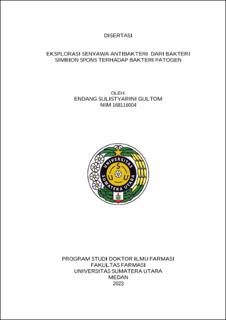| dc.description.abstract | Background:Theproblem of infectious diseasesis increasing every year,oneofthe causesis that bacteriaareresistant to certain antibotics.An alternativesearchforsources of new activecompoundsis to usebacteria that arein symbiosis withsponges. Themethod in this research is experimental with descriptivedata analysis.Researchpurposes:Theaimof this research is to determinecompoundsproducedby spongesymbiontbacteriathat havethe potential to act as antibacterials againstStaphylococcus lugdunensisESBL, Pseudomonas aeruginosaESBL and Klebsiella pneumoniaeESBL using the LC-MS(MS) method. Results: Based on the research, 30 isolates of bacteria wereobtained that weresymbiotic with the Agelassp sponge, 10 of which had the potential as antibacterialsagainstKlebsiella pneumoniaeESBL, Pseudomonas aeruginosa ESBL, and Staphylococcus lugdunensisESBL. Theresults of the analysis usingthe VITEK2System, the predicted species included Pseudomonas aeruginosa, Sphingomonas paucimobilis, Myroides spp, Vibrio alginolycticus, andChromobacteriumviolaceum, and therewere2 isolates that werepredicted to beunidentified organisms. Theresults of phylogeneticanalysis showed that isolatesIA5and IA7wereBacillus cereuswith asimilarity level of99.27%-99.88%; isolates IA6, IA10 and IA24 arePseudomonas aeruginosawith asimilarity level of 99.19%-99.73%; isolates IA7, IA8, and IA9 grouped in the genus Alcaligenes such as Alcaligenesfaecalis, Alcaligenes aquatilis, and Alcaligenes javaensis; and isolates IA12 andIA16 groupedin the Vibrio genus such as Vibrio parahaemolyticusandVibrio alginolyticus. Potential spongesymbiontbacteria that continuewith the secondarymetabolite extraction process areBacillus cereus, Pseudomonas aeruginosa, and Alcaligenes sp. Conclusion: Theresearch results showed that fraction 6 of Bacillus cereushad 7 activecompoundswhich had antibacterial activity, namely DL-phenylalanine,noradrenaline, L-(+)-leucine, DLtyrosine,L-(+)-valine, cholineand cyclo(leucylprolyl). Fraction 4Pseudomonas aeruginosahas 5 activecompoundswhich havetheantibacterial activity ofcaprolactam, tridemorph, DEET, (9Z)-9-octadecenamideand amideC18. Fraction 5 Alcaligenessp has 5 activecompoundswhich haveantibacterial activity, namely DL-phenylalanine, L-(+)-Leucine, caprolactam, inspra and choline. | en_US |


